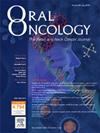Loss of MACROD2 drives radioresistance but not cisplatin resistance in HPV-positive head and neck cancer
IF 4
2区 医学
Q1 DENTISTRY, ORAL SURGERY & MEDICINE
引用次数: 0
Abstract
Head and neck squamous cell carcinoma (HNSCC) is the sixth most common cancer type worldwide. In recent years, there has been an increase in the rate of HNSCC cases attributed to the infection of the oropharynx by the human papillomavirus (HPV). Given the significant treatment-related toxicities of the current standard of care for HPV-positive HNSCC, there is an urgent need for the development of precision patient stratification and treatment strategies to improve patients’ quality of life while maintaining excellent survival rates. We have previously carried out whole genome sequencing of HPV+ HNSCC tumors that failed concurrent cisplatin and radiation treatment and discovered that MACROD2 deletion is enriched among these tumors. In the current study, we sought to investigate the mechanistic role of MACROD2 in HPV+ HNSCC treatment resistance. Our results indicate that MACROD2 depletion in HNSCC cell lines leads to increased cell viability and colony formation capacity. Interestingly, MACROD2 depletion did not alter cisplatin sensitivity but led to an increase in radiation resistance of HPV+ HNSCC cell lines. RNA sequencing and immunofluorescence microscopy demonstrated that MACROD2-depleted HPV+ HNSCC cells displayed elevated levels of hypoxia and an altered DNA damage response. Taken together, this study establishes and characterizes the role of MACROD2 in HPV+ HNSCC radioresistance. Further work is needed to validate MACROD2 as a biomarker of treatment failure and to understand how to overcome the identified molecular mechanisms of resistance.
MACROD2的缺失会导致HPV阳性头颈癌产生放射抗药性,但不会导致顺铂抗药性。
头颈部鳞状细胞癌(HNSCC)是全球第六大常见癌症类型。近年来,由于人乳头瘤病毒(HPV)感染口咽部,导致 HNSCC 病例增加。鉴于目前治疗人乳头瘤病毒阳性 HNSCC 的标准疗法存在严重的治疗相关毒性,因此迫切需要开发精准的患者分层和治疗策略,以改善患者的生活质量,同时保持良好的生存率。我们曾对顺铂和放射治疗失败的HPV+ HNSCC肿瘤进行了全基因组测序,发现这些肿瘤中富含MACROD2缺失。在本研究中,我们试图探究MACROD2在HPV+ HNSCC耐药中的机制作用。我们的研究结果表明,在 HNSCC 细胞系中缺失 MACROD2 会导致细胞活力和集落形成能力增强。有趣的是,MACROD2 的缺失不会改变顺铂的敏感性,但会导致 HPV+ HNSCC 细胞系的耐辐射性增加。RNA 测序和免疫荧光显微镜检查表明,去除了 MACROD2 的 HPV+ HNSCC 细胞缺氧水平升高,DNA 损伤反应也发生了改变。综上所述,本研究确定并描述了MACROD2在HPV+ HNSCC放射抗性中的作用。要验证 MACROD2 作为治疗失败的生物标志物,并了解如何克服已确定的耐药性分子机制,还需要进一步的工作。
本文章由计算机程序翻译,如有差异,请以英文原文为准。
求助全文
约1分钟内获得全文
求助全文
来源期刊

Oral oncology
医学-牙科与口腔外科
CiteScore
8.70
自引率
10.40%
发文量
505
审稿时长
20 days
期刊介绍:
Oral Oncology is an international interdisciplinary journal which publishes high quality original research, clinical trials and review articles, editorials, and commentaries relating to the etiopathogenesis, epidemiology, prevention, clinical features, diagnosis, treatment and management of patients with neoplasms in the head and neck.
Oral Oncology is of interest to head and neck surgeons, radiation and medical oncologists, maxillo-facial surgeons, oto-rhino-laryngologists, plastic surgeons, pathologists, scientists, oral medical specialists, special care dentists, dental care professionals, general dental practitioners, public health physicians, palliative care physicians, nurses, radiologists, radiographers, dieticians, occupational therapists, speech and language therapists, nutritionists, clinical and health psychologists and counselors, professionals in end of life care, as well as others interested in these fields.
 求助内容:
求助内容: 应助结果提醒方式:
应助结果提醒方式:


